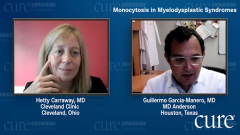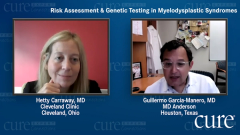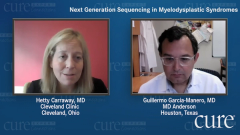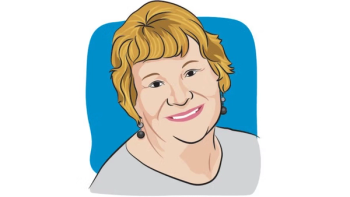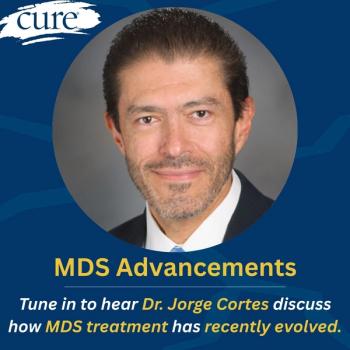
Treatment Approach in Myelodysplastic Syndromes
Episodes in this series

Hetty Carraway, MD: Let’s briefly switch to therapy for MDS [myelodysplastic syndromes] as a topic, now that we’ve covered the presentation of MDS and some of the things that we use in terms of testing and diagnosis. Can you talk about some of the first-line treatment options for patients with MDS and what type of patient might be in that first line of therapy?
Guillermo Garcia-Manero, MD: Before we go into that, I think the key factor is to briefly discuss the prognostic systems, because that’s basically how we then think of therapy. There are two scoring systems used simultaneously. One is an older scoring system that we call the IPSS [International Prognostic Scoring System], and a more recent one called the IPSS-R [Revised International Prognostic Scoring System] that is almost 10 years old. Using these two classifications, we can divide patients into lower-risk or higher-risk categories. If it’s IPSS lower, it’s low and intermediate-1; high is intermediate-2 and high. If you’re using IPSS-R, it’s a little bit more complicated because it has five categories. What we call very low/low is lower risk. High/very high is higher risk. Then there is the intermediate subset, which we tend to break it into two: low/intermediate and high/intermediate. That’s a little bit complicated. That’s why the IPSS is still better, and we’re looking for molecular classification to help us. The bottom line is that you will divide patients into lower and higher categories.
The other thing that you look at is the age of the patient, because most patients are older than 70. The median age is around 72 or 73 years, but we see patients in their 50s and 60s, so it’s not that this cannot happen to even kids in some particular situations. So you look at their age, the risk by the IPSS, and you also look at comorbidities. Does the patient have some other comorbidity, such as cardiovascular disease, diabetes, or what have you? Then you put all of that together. For lower risk, where traditionally the goal may be in improving cytopenias, the goal is to make the anemia better and see if we can increase the platelet count. It’s not so much about being aggressive in terms of curing this disease, because lower-risk disease for many patients can be something that takes many years to become problematic.
I believe there are some patients with lower-risk disease where prevention is really important. This is not prevention per se, but the question is if it’s possible that there are some patients with lower-risk MDS for whom you can predict a more aggressive behavior, where perhaps an early, slightly more aggressive type of therapy could be considered. Then you have the patients with the higher-risk disease. This now requires more aggressive treatment because some of these cases can transform to acute leukemia, or more frequently, have major complications from the myelodysplastic syndrome itself, such as infections or bleeding. This, unfortunately, can cause the death of the patient.
So the question is deciding which type of chemotherapy to use. Traditionally, most patients are treated with a low-intensity type of chemotherapy with drugs that we call hypomethylating agents, such as azacitidine or decitabine. Some patients who are younger or have particular chromosomes or mutations may be candidates for more intensive therapy, like treatment for acute myelogenous leukemia. Likely for some of the patients with high-risk disease, the way to cure this disorder is to proceed with an allogeneic stem cell transplantation. That’s a very aggressive procedure that requires donors, and also requires probably younger patients who are able to sustain and survive that type of procedure. That is the thought process that we go with on our first visit: lower or high risk, age, the cytogenetics, and molecular classification; because with all this information, we can then map the more appropriate approach in terms of therapy.
Hetty Carraway, MD: That was beautiful in terms of clarifying. We use these prognostic scoring systems: the IPSS, which is the International Prognostic Scoring System, or the IPSS-R, which is the Revised International Prognostic Scoring System, and Dr. Garcia-Manero just went through the way we use those tools to get a score that helps us to identify each patient as having lower-risk MDS or higher-risk MDS. Once we know that classification in terms of score, that helps us understand if this particular MDS is at high risk of progression to an acute myeloid leukemia. If it is, it classically sits in this high-risk or higher-risk MDS category, and we want to move forward to recommend interventions, such as chemotherapy with hypomethylating agents, to delay the time to progression to leukemia. We potentially even talk about a curative therapy, such as a bone marrow transplant, for those who qualify for such an aggressive therapy.
Obviously, the treatment goals for patients with a diagnosis of MDS include trying to cure the disease, such as through a transplant, to improve the overall survival, and lower the risk of transformation to leukemia. We also hope to get the disease under control such that there’s better production, if you will, from that bone marrow factory where you have normalization of counts such as the hemoglobin, the platelet count, and the neutrophils. For those patients who have issues with counts being low, manyneed and require transfusion support. So doing things to decrease the need for transfusion support can also be very meaningful for patients in terms of their quality of life. It means that they spend less time at the hospital or in the clinic. If they have issues with frequent infections because of low counts, if we can have normalization of the counts, that can decrease their risk of infection and problems in terms of quality of life.
We’ve talked a lot about the higher-risk MDS category, and I’m sure we’ll talk more about the therapies for the high-risk category.
Transcript Edited for Clarity


